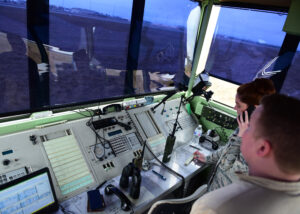“Every year we see the consequences of increasing incidents of flooding, drought, wildfires, and extreme weather events on our installations at home,” Austin said in a Jan. 28 statement.
In 2019 alone, he said, 79 military bases suffered consequences of climate-related events.
Austin’s directive came on the heels of a Jan. 27 White House executive order that said “climate considerations shall be an essential element of United States foreign policy and national security.”
To prepare for what could be more catastrophic climate effects in the future, DoD will conduct wargames and risk assessments, said Austin. “We will include the security implications of climate change in our risk analyses, strategy development and planning guidance.”
The specifics of how Austin’s guidance “breaks down into dollar amounts” have yet to be worked out, Pentagon press secretary John Kirby told reporters. He said it could take a few months to identify what resources might be needed.
The military unit primarily responsible for weather forecasting is the Air Force 14th Weather Squadron, based in Asheville, N.C. The squadron uses data from ground and space based sources to develop weather forecasts used to plan military operations and to determine climate change impacts.
Military weather satellites include the Defense Meteorological Satellite Program and the Electro-Optical/Infrared Weather System–Geostationary (EWS-G) which provide data to the 14th Weather Squadron. The U.S. Space Force is buying a new satellite called Weather System Follow-on-Microwave (WSF-M) and is evaluating concepts for a new Electro-Optical/Infrared Weather System constellation in low-Earth orbit.
A Space Force spokesman said the service currently “does not operate and is not developing capabilities specifically to monitor climate change” and will continue to work with civil agencies like NASA and the National Oceanic and Atmospheric Administration to address weather surveillance needs.
The spokesman said the Space Force is considering future investments to improve weather monitoring in the Arctic, a region considered strategically important and where melting ice could cause significant disruption. The Air Force and the Space Force have installations across Alaska, Canada, and Greenland including satellite command and control stations, and a network of more than 50 early warning and missile defense radars.
A study is under way to “determine if additional space-based capabilities are needed to monitor arctic conditions, or if ground-based capabilities will suffice,” the spokesman said.
Weather surveillance technologies
Industry executives told SpaceNews that the new emphasis on climate change could create opportunities for the military to invest in advanced sensors and to take advantage of lower cost satellites. They point out that the Air Force for years struggled to replace aging weather satellites. Congress also has been critical over the years of the Air Force’s weather satellite programs.
As climate events become more extreme and impactful, the military will need more timely and more precise data, said Shawn Cochran, a business development executive at Raytheon Intelligence & Space.
He said the Space Force will be playing catchup after years of funding cuts to weather satellite programs. “No matter all the good intentions, any time there’s been austerity in budgets it seems they’ve raided the capabilities in weather to pay for other programs,” Cochran said.
NASA is the nation’s lead agency for climate research and it would not make sense for DoD to duplicate existing efforts, said Cochran. DoD however could benefit from the innovation in low-flying satellites that provide more frequent observations, he said.
Raytheon is one of three competitors in the Electro-Optical/Infrared Weather System program run by the U.S. Space Force’s Space and Missile Systems Center.
Raytheon, General Atomics and Atmospheric & Space Technology Research Associates are developing competing space sensors to provide global cloud characterization and theater weather imagery.
Capt. Kaitlin Toner, spokesperson for the Space and Missile Systems Center, said the evaluation of prototypes should be completed in March, and one or two of the three proposals will be selected for further development. The plan is to deploy new satellites by 2025.
John Fisher, president of Brandywine Photonics, said new DoD investment could help fill weather data gaps at lower cost than was previously possible.
Brandywine Photonics won an Air Force small business research contract to design a compact hyperspectral infrared sounding small satellite sensor to measure water vapor and temperature profiles. This technology can be used for military weather forecasts and for detecting greenhouse gases.
“With the Biden administration, we expect to see much stronger support for dual-use infrared sounding and hyperspectral land imaging satellite payloads in the Space Force, National Reconnaissance Office, and the Space Development Agency,” Fisher said.
Cheaper small satellites and launch, and availability of optical inter-satellite links to move data are key trends that DoD could tap to get fast and reliable weather data, said Fisher. A constellation of just 14 satellites could provide hourly revisits, he said. And with optical links, weather observations can be obtained in minutes.



